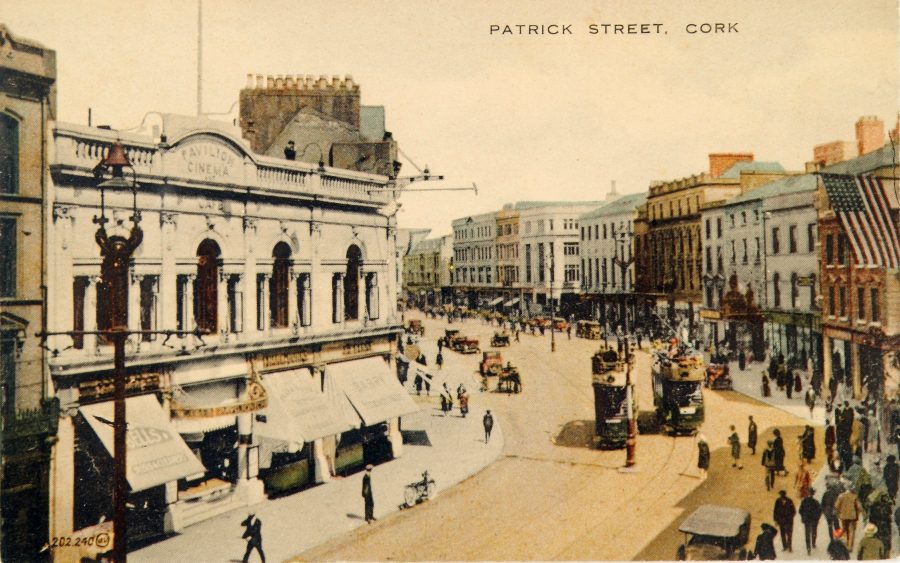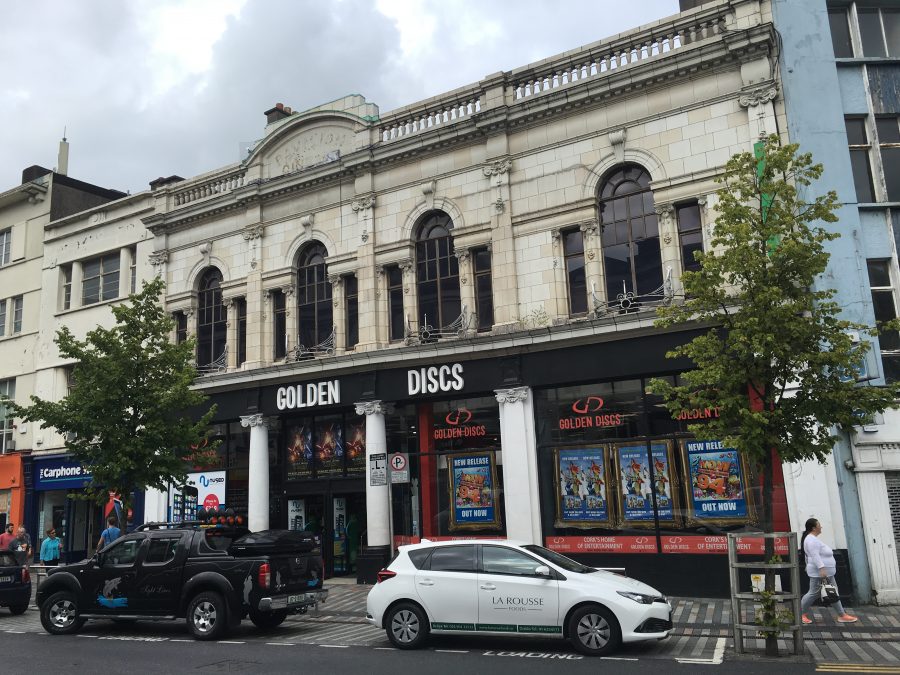
Kieran’s Our City, Our Town Article,
Cork Independent, 11 March 2021
Journeys to a Truce: The Opening of the Pavilion
Against the backdrop of the ruins on St Patrick’s Street from the Burning of Cork and the unsettling tit-for-tat violence across Cork City’s streets, the opening of the decorative Pavilion Cinema in early March 1921 was a very different and positive event of that time.
Cinema was a very popular form of entertainment in the 1910s and 1920s. Up to 1921 and before the Pavilion’s construction, Cork could boast having seven cinemas– Picturedrome at the Assembly Rooms on the South Mall, Imperial Cinema on Oliver Plunkett Street, The Washington Cinema on Washington Street, Bellevue at Barrackton, Lido Cinema on Watercourse Road, Lee Cinema on Winthrop Street and the community picture drome at St Mary’s Hall opposite the North Cathedral. The Picture Palace, 40-42 Grand Parade, was also in the course of construction.
The press commentary on 7 March 1921 in the Cork Examiner described the Pavilion as a “super cinema of the very latest, rich in design and finish”. Passing through the imposing and spacious entrance in St Patrick’s Street, two flights of broad marble stairs were ascended from the centre of the hallway. Here was the café and ballroom in a colour scheme of French grey.
The Cork Examiner further elaborates on the design: “The rose du Barri with gold with a fine arrangement of French mirrors and lustre lighting effects, and the artistic workmanship of the ceiling all combine in the richest and most artistic harmony. Then there is the oak panelled smokeroom where one could sit. Here there are lanterns hanging from the oak beams. The construction, ornamental and decorative work of the cinema portion of the buildings are superb in design and colour, while the seating is made to provide the most luxurious comfort”.
Great credit was given to the Dublin architect Thomas Francis McNamara for his design. McNamara was a popular architect who received a considerable number of commissions in the early twentieth century connected with the Catholic church, particularly for buildings in the Diocese of Dromore. He had become architect to the Dublin Joint Hospital Board and was later increasingly engaged in hospital work. His pupils and assistants included Harry Clarke whom he advised to take up art rather than architecture as a profession. McNamara travelled often in France, Italy and Spain. He had a special interest in Hispano-Romanesque architecture, which is an interest he brought to the design of the Pavilion.
The capacity of the Pavilion cinema was 900 people while the tea and smoke rooms could accommodate comfortably 150 persons. The luxurious furnishing was carried out by Cork’s Munster Arcade and the decorating and painting was completed by Messrs John O’Connell, Cork. On the ground floor three shops and managerial offices were fitted in. The entrance to the chief seats were viz – balcony and back parterre is on St Patrick’s Street and the front parterre seats entrance was in Carey’s Lane.
The cinema was originally conceived by T J Moran and other investors. The contractor though was Mr Moran’s firm. Under his direction, the ornamental, decorating and furnishing the theatre and café was carried out. The resident orchestra was under the direction of Dr William George Eveleigh and Signor Grossi, leader and violinist. Dr Eveleigh was an organist in St Finbarre’s Cathedral.
Ferrouccio Grossi was a lecturer in the Cork School of Music on violin, viola, and conductor of orchestra. He was part of a small orchestra of foreign musicians of various nationalities who had been engaged for the Cork International Exhibition in 1902. In the same year, Grossi took up residence in Cork, and with his pianist wife, began a career of concert hosting and teaching, up to 1930.
The Pavilion was to be managed by Mr Fred Harford, formerly of the Abbey Theatre. There he was a long standing actor there and eventually became manager of the venue.
Opening on 10 March 1921, the programme of the new Pavilion Cinema was composed of what was deemed “highest class items” and it included a violin solo by Signor Grossi and music by Dr Eveleigh’s orchestra.
D W Griffith’s “The Greatest Question” was the principal film. Griffith was an American film director and was one of the pioneers of the financing of the feature-length movie. Circa 1919-1920 together with Douglas Fairbanks, Charlie Chaplin and Mary Pickford, he established United Artists, allowing them to plan their own interests, rather than be dependent on commercial studios. By the time he made his final film he had made near 500 films.
Based upon a novel by William Hale, the silent film, The Greatest Question, had a plot about an orphan girl being given shelter by a farm family, but soon finds herself in the hands of a murderous farmer and his wife. The film also had ghostly apparitions and would have been deemed a thriller genre in its day.
The film was supported by one of Burton Holmes interesting travel pictures and also by a comedy entitled “It’s a Boy”. Burton Holmes was the first person to blend travel stories, slides shows and motion pictures into documentary travel lectures, for which he coined the word “travelogue”. By the turn of the twentieth century Holmes was recognised as America’s leading travel lecturer. Holmes generally spent six months of each year travelling and photographing in various locations. His 1920-21 material for showing in cinemas is listed on his American archive at the US Smithsonian Institution and includes Constantinople Under Allied Control, Jerusalem – Holy City of Three Faiths, Gardens of Allah and the Barbary Coast, Spanish Cities and the Pyrenees, Vision of Venice and the Italian Lakes. Some or all of these may have been shown before the main feature at the Pavilion in Cork in the Spring of 1921.
Captions:
1090a. Pavilion Cinema, St Patrick’s Street, late 1920s from Cork City Through Time by Kieran McCarthy and Dan Breen.
1090b. Golden Discs, former Pavilion Cinema, St Patrick’s Street, present day (picture: Kieran McCarthy).
